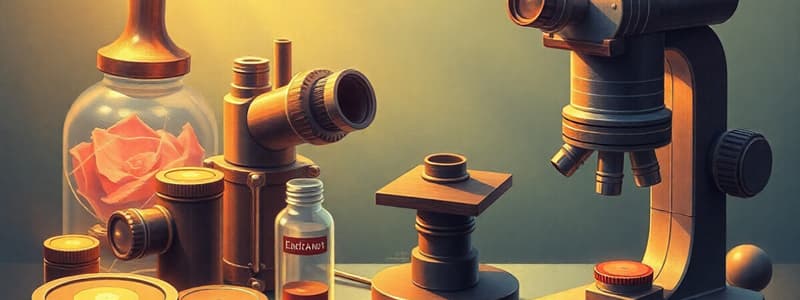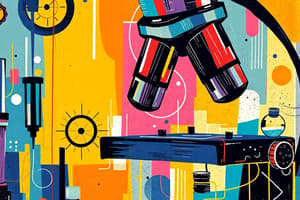Podcast
Questions and Answers
What role does the diaphragm play in a microscope?
What role does the diaphragm play in a microscope?
The diaphragm controls the amount of light reaching the specimen.
Explain the difference between coarse focus knob and fine focus knob.
Explain the difference between coarse focus knob and fine focus knob.
The coarse focus knob adjusts the stage height for large movements, while the fine focus knob allows for precise focusing.
What is the main feature that distinguishes dark-field microscopy from bright-field microscopy?
What is the main feature that distinguishes dark-field microscopy from bright-field microscopy?
Dark-field microscopy uses oblique light to illuminate the specimen, making it appear bright against a dark background.
How does phase contrast microscopy enhance the visibility of transparent specimens?
How does phase contrast microscopy enhance the visibility of transparent specimens?
What is the primary use of fluorescence microscopy?
What is the primary use of fluorescence microscopy?
What is the advantage of using confocal microscopy over traditional microscopy techniques?
What is the advantage of using confocal microscopy over traditional microscopy techniques?
Describe the fundamental difference between Transmission Electron Microscopy (TEM) and Scanning Electron Microscopy (SEM).
Describe the fundamental difference between Transmission Electron Microscopy (TEM) and Scanning Electron Microscopy (SEM).
What is the function of the condenser in a microscope?
What is the function of the condenser in a microscope?
Flashcards are hidden until you start studying
Study Notes
Microscope Components
-
Optical Components
- Eyepiece (Ocular Lens): The lens you look through, usually 10x or 15x magnification.
- Objective Lenses: Multiple lenses with different magnifications (e.g., 10x, 40x, 100x).
- Condenser: Focuses light onto the specimen; adjustable to enhance image clarity.
- Diaphragm: Controls the amount of light reaching the specimen.
-
Mechanical Components
- Stage: Flat platform where the slide is placed; may have mechanical stage controls.
- Arm: Supports the optical components and connects them to the base.
- Base: The bottom support of the microscope; holds the light source.
- Stage Clips: Hold the slide in place on the stage.
-
Illumination Components
- Light Source: Usually LED or halogen; illuminates the specimen.
- Mirror (in older models): Reflects natural light for illumination.
-
Focusing Mechanism
- Coarse Focus Knob: Adjusts the stage height for large movements; used for initial focusing.
- Fine Focus Knob: Allows for precise focusing to clearly view the specimen.
Microscopy Techniques
-
Bright-Field Microscopy
- Standard technique using transmitted light.
- Specimens appear dark against a bright background.
- Good for stained samples and general observations.
-
Dark-Field Microscopy
- Uses oblique light to illuminate the specimen.
- Specimens appear bright against a dark background.
- Useful for identifying small particles and live microorganisms.
-
Phase Contrast Microscopy
- Enhances contrast of transparent specimens.
- Utilizes differences in refractive index to create contrast.
- Effective for living cells without staining.
-
Fluorescence Microscopy
- Uses fluorescent dyes to label specific structures within the specimen.
- Specimens are illuminated with specific wavelengths of light.
- Useful in molecular biology for visualizing specific proteins or nucleic acids.
-
Confocal Microscopy
- Uses a laser and optical sectioning to create images.
- Provides high-resolution images of thick specimens in multiple layers.
- Ideal for 3D reconstruction of samples.
-
Electron Microscopy
- Provides much higher resolution than optical microscopy.
- Transmission Electron Microscopy (TEM): Electrons pass through specimen; suitable for internal structures.
- Scanning Electron Microscopy (SEM): Electrons scan the surface; provides 3D images of surfaces.
-
Super Resolution Microscopy
- Techniques such as STED, PALM, or STORM that surpass the diffraction limit of light.
- Allows observation of structures at nanometer resolution.
-
Live Cell Imaging
- Techniques designed to observe biological processes in live cells.
- Minimizes photodamage and phototoxicity for long-term studies.
Microscope Components
-
Optical Components: These components control how light interacts with the specimen and your eye.
- Eyepiece (Ocular Lens): This is the lens you look through. It typically magnifies the image 10x or 15x.
- Objective Lenses: There are multiple lenses with different magnifications, such as 10x, 40x, and 100x.
- Condenser: This focuses light onto the specimen. Adjusting the condenser helps create a clear image.
- Diaphragm: This controls the amount of light reaching the specimen, allowing you to adjust the brightness and contrast.
-
Mechanical Components: These components provide the physical structure and movement for the microscope:
- Stage: This is the flat platform where the slide (specimen) is placed. Some stages have mechanical controls to move the slide.
- Arm: This supports the optical components and connects them to the base.
- Base: This is the bottom support of the microscope, holding the light source.
- Stage Clips: These hold the slide in place on the stage.
-
Illumination Components: These components provide the light source for viewing the specimen.
- Light Source: Modern microscopes often use LED or halogen bulbs for illumination.
- Mirror (in older models): Older microscopes used mirrors to reflect natural light for illumination.
-
Focusing Mechanism: These components allow you to adjust the focus of the image.
- Coarse Focus Knob: This adjusts the stage height for large movements, used for initial focusing.
- Fine Focus Knob: This allows for precise focusing to bring the specimen into sharp view.
Microscopy Techniques
-
Bright-Field Microscopy: This is the most common type of microscopy.
- It uses transmitted light, meaning light passes through the specimen.
- The specimen appears dark against a bright background.
- This technique is useful for visualizing stained samples and for general observation.
-
Dark-Field Microscopy: In this technique, light is directed at the specimen from an oblique angle.
- The specimen appears bright against a dark background because only light that is scattered by the specimen reaches the objective.
- This technique is helpful for identifying small particles and live microorganisms that may be difficult to see with bright-field microscopy.
-
Phase Contrast Microscopy: This technique is used to enhance the contrast of transparent specimens.
- It utilizes differences in the refractive index of different parts of the specimen to create contrast.
- This technique is particularly effective for viewing living cells without the need for staining.
-
Fluorescence Microscopy: This technique uses fluorescent dyes to label specific structures within the specimen.
- The specimen is illuminated with a specific wavelength of light that excites the fluorescent dye.
- This technique is very useful in molecular biology for visualizing specific proteins or nucleic acids.
-
Confocal Microscopy: This technique uses a laser to illuminate the specimen and a pinhole aperture to block out-of-focus light.
- The laser scans the specimen point-by-point, creating a series of optical sections.
- These sections can be stacked together to create a 3D reconstruction of the specimen.
- This technique is ideal for visualizing thick specimens, such as tissues, with high resolution.
-
Electron Microscopy: This technique uses electrons instead of light to create an image.
- Transmission Electron Microscopy (TEM): In this technique, electrons pass through the specimen, providing information about the internal structures.
- Scanning Electron Microscopy (SEM): In this technique, electrons scan the surface of the specimen, providing 3D images of the surface.
- Electron microscopy offers much higher resolution than optical microscopy techniques.
-
Super Resolution Microscopy: This category includes techniques that surpass the diffraction limit of light, allowing visualization of structures at the nanometer scale.
- Examples include: STED, PALM, and STORM.
-
Live Cell Imaging: This category encompasses several techniques designed to observe dynamic biological processes in living cells.
- These techniques minimize photodamage and phototoxicity, enabling long-term studies of cellular activity.
Studying That Suits You
Use AI to generate personalized quizzes and flashcards to suit your learning preferences.




